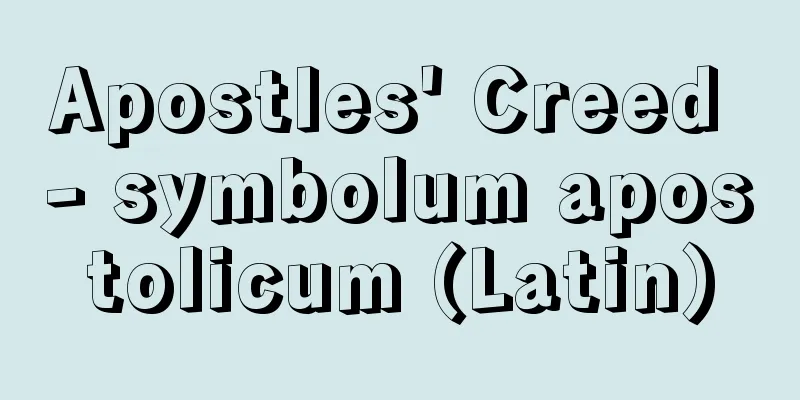Apostles' Creed - symbolum apostolicum (Latin)

|
From the very beginning, the Christian Church used simple formulas to express the content of faith for apologetics and teaching. The seeds of such creeds can already be found in the New Testament (e.g., Corinthians 15:3ff.). The current Apostles' Creed was created in Gaul in the 5th or 6th century, but its origin, the Old Roman Creed, dates back to the middle of the 2nd century. As heretical teachings developed, the word symbolum came to be used for this creed, since it was a "sign" that distinguished true Christians from unbelievers and heretics. The traditional text is as follows: "I believe in God the Father Almighty, Creator of heaven and earth. And in his only Son, our Lord, Jesus Christ, who was conceived by the Holy Spirit, born of the Virgin Mary, suffered under Pontius Pilate, was crucified, died and was buried, descended into hell, rose from the dead on the third day, ascended into heaven, and sits at the right hand of God the Father Almighty, from whence he will come to judge the living and the dead. I believe in the Holy Spirit, the holy catholic church, the communion of saints, the forgiveness of sins, the resurrection of the body, and eternal life. Amen." Source: Shogakukan Encyclopedia Nipponica About Encyclopedia Nipponica Information | Legend |
|
キリスト教会はきわめて初期のころから、弁証と教育のために信仰の内容を表現するうえで簡単な定式を用いていた。『新約聖書』のなかにすでにそのような信条の萌芽(ほうが)をみることができる(「コリント書」15章3以下など)。現在の使徒信条はガリアで5、6世紀にできたものであるが、その元となる古ローマ信条は2世紀の中ごろにまでさかのぼる。異端的な教えが発展するにつれて、この信条が真のキリスト者を不信者や異端者から区別する「しるし」となるところから、この信条に対してシンボルムsymbolum(象徴)ということばを使うようになった。伝承された本文は次のごとくである。「我は天地の造り主、全能の父なる神を信ず。我はその独り子、我らの主、イエス・キリストを信ず。主は聖霊によりてやどり、処女マリアより生まれ、ポンテオ・ピラトのもとに苦しみを受け、十字架につけられ、死にて葬られ、陰府(よみ)にくだり、3日目に死人のうちよりよみがえり、天にのぼり、全能の父なる神の右に座したまえり、かしこより来りて生ける者と死ねる者とを審(さば)きたまわん。我は聖霊を信ず、聖なる公同の教会、聖徒の交わり、罪の赦(ゆる)し、身体(からだ)のよみがえり、永遠の生命(いのち)を信ず。アーメン」 出典 小学館 日本大百科全書(ニッポニカ)日本大百科全書(ニッポニカ)について 情報 | 凡例 |
>>: Poetry and Poetics - Shishiron
Recommend
Castle, V. (English spelling) Castle V
…The fast-paced quick waltz is called the Viennes...
Cassiopeia
(Kassiopeia) In Greek mythology, she was the wife ...
Normative I sentence - normative I sentence
…It is a character that evolved from a pictograph...
Snow patch
Snow that does not melt and remains in mountain v...
ANSI - Ansi
American National Standards Institute. A non-profi...
Kujo Annual Events - Kujo Annual Events
Written by Fujiwara no Morosuke, Minister of the ...
Extrinsic motivation
…Traditionally, motivation was thought to be caus...
Ookusabok - Ookusabok
…Some species have edible young shoots, while oth...
Mount Palomar
A mountain in southwestern California, USA. It is ...
Some companies - Kisha (English spelling) Jǐ shè
A literary society founded in the Huating Pavilion...
How I Became A Christian
...His academic achievements were at the level of...
Yasaka Yahama
A coast facing the Kii Channel in southeastern To...
Snakehead - Snakehead
A fish of the family Cobitidae. It is a general te...
Zebra finch (Japanese name: Kinkadori) - Zebra finch (English name: Kinkadori)
A bird of the family Acanthidae (illustration) in ...
Epidemic typhus
What kind of infection is it? It is an acute febr...









